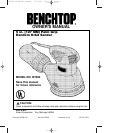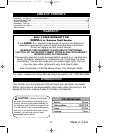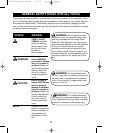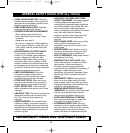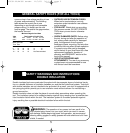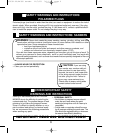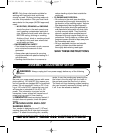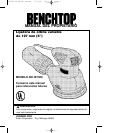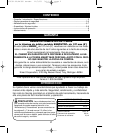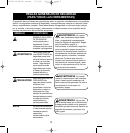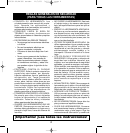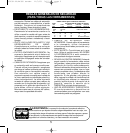
4
• KNOW YOUR POWER TOOL. Read this
owner's manual carefully. Learn your tool's
applications and limitations, as well as the
possible hazards related to it.
• KEEP WORK AREA CLEAN. Cluttered
areas and benches invite injuries.
•
CONSIDER WORK AREA ENVIRONMENT.
•Don’t expose power tools to rain.
•Don’t use power tools in damp or wet
locations.
•Keep work area well lit.
•Do not use in presence of flammable liq-
uids or gases. Motors in these tools nor-
mally spark, and the sparks may ignite
the fumes.
• GUARD AGAINST ELECTRIC SHOCK.
Prevent body contact with grounded
surfaces. For example; pipes, radiators,
ranges, refrigerator enclosures. Use
extreme caution when drilling, driving, or
cutting into walls, floors, ceilings or other
areas or wherever live electrical wires may
be contacted, do not touch any metal parts
of the tool. Hold the tools only by the plastic
handle to prevent electric shock.
• KEEP CHILDREN AWAY. Do not let
children and visitors contact tool or
extension cord. All children and visitors
should be kept away from work area.
• STORE IDLE TOOLS. When not in use,
tools should be stored in dry, and high or
locked-up place–out of reach of children.
• DON’T FORCE TOOL. It will do the job
better and safer at the rate for which it was
intended.
• USE RIGHT TOOL. Don’t force small tool or
attachment to do the job of a heavy-duty
tool. Don’t use tool for purposes not
intended.
• DRESS PROPERLY. Do not wear loose
clothing or jewelry. They can be caught in
moving parts. Rubber gloves and non-skid
footwear are recommended when working
outdoors. Wear protective hair covering to
contain long hair.
• USE SAFETY GLASSES AND OTHER
SAFETY EQUIPMENT. Use safety goggles
or safety glasses with side shields,
complying with applicable safety standards
and, when needed, a face shield. Also use
face or dust mask if cutting operation is
dusty. This applies to all persons in the work
area. Also use a hard hat, hearing
protection, gloves, safety shoes and dust
collection systems when specified or
required.
• DON’T ABUSE CORD. Never carry tool by
cord or yank it to disconnect from
receptacle. Keep cord from heat, oil, and
sharp edges.
• SECURE WORK. Use clamps or a vise to
hold work. It’s safer than using your hand
and it frees both hands to operate tool.
• DON’T OVERREACH. Keep proper footing
and balance at all times.
• MAINTAIN TOOLS WITH CARE. Keep
tools sharp and clean for better and safer
performance. Follow instructions for
lubricating and changing accessories.
Inspect tool cords periodically and replace if
damaged. Inspect extension cords
periodically and replace if damaged. Keep
handles dry, clean, and free from oil and
grease.
• DISCONNECT TOOLS. Unplug the tool
when not in use, when moving tool from
place to place, before servicing, and when
changing accessories (such as blades, bits,
cutters) or making adjustments.
• REMOVE ADJUSTING KEYS AND
WRENCHES. Form habit of checking to see
that keys and adjusting wrenches are
removed from tool before turning it on.
• AVOID UNINTENTIONAL STARTING.
Don’t carry tool with finger on switch. Be
sure switch is off when plugging in.
• EXTENSION CORDS. Make sure your
extension cord is in good condition. When
using an extension cord, be sure to use one
heavy enough to carry the current your
product will draw. An undersized cord will
GENERAL SAFETY RULES (FOR ALL TOOLS)
IMPORTANT! READ ALL INSTRUCTIONS!
607691-00/BT300 Sander 11/3/03 3:14 PM Page 4



